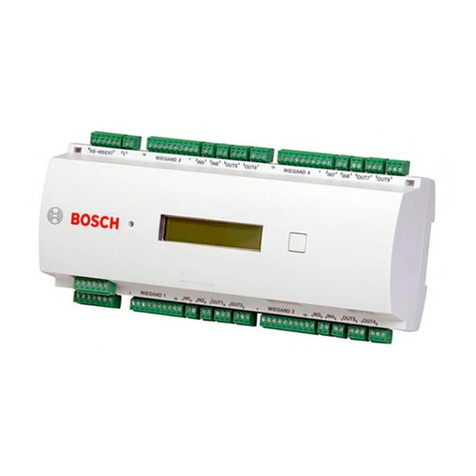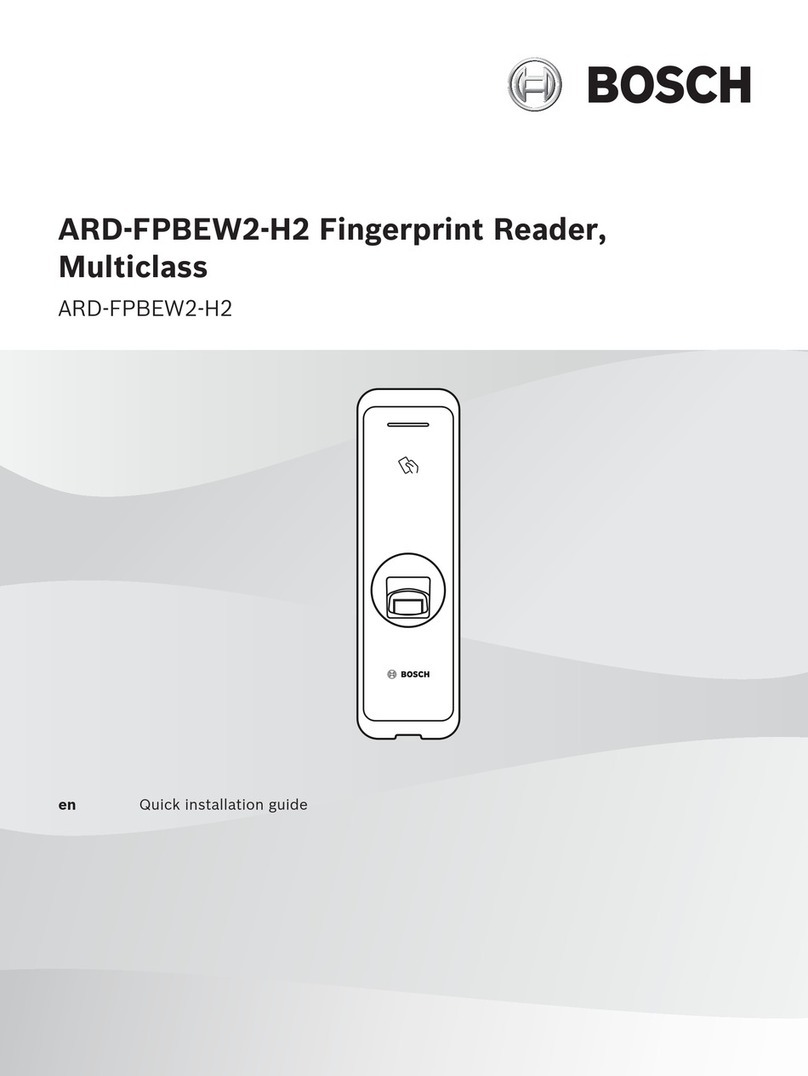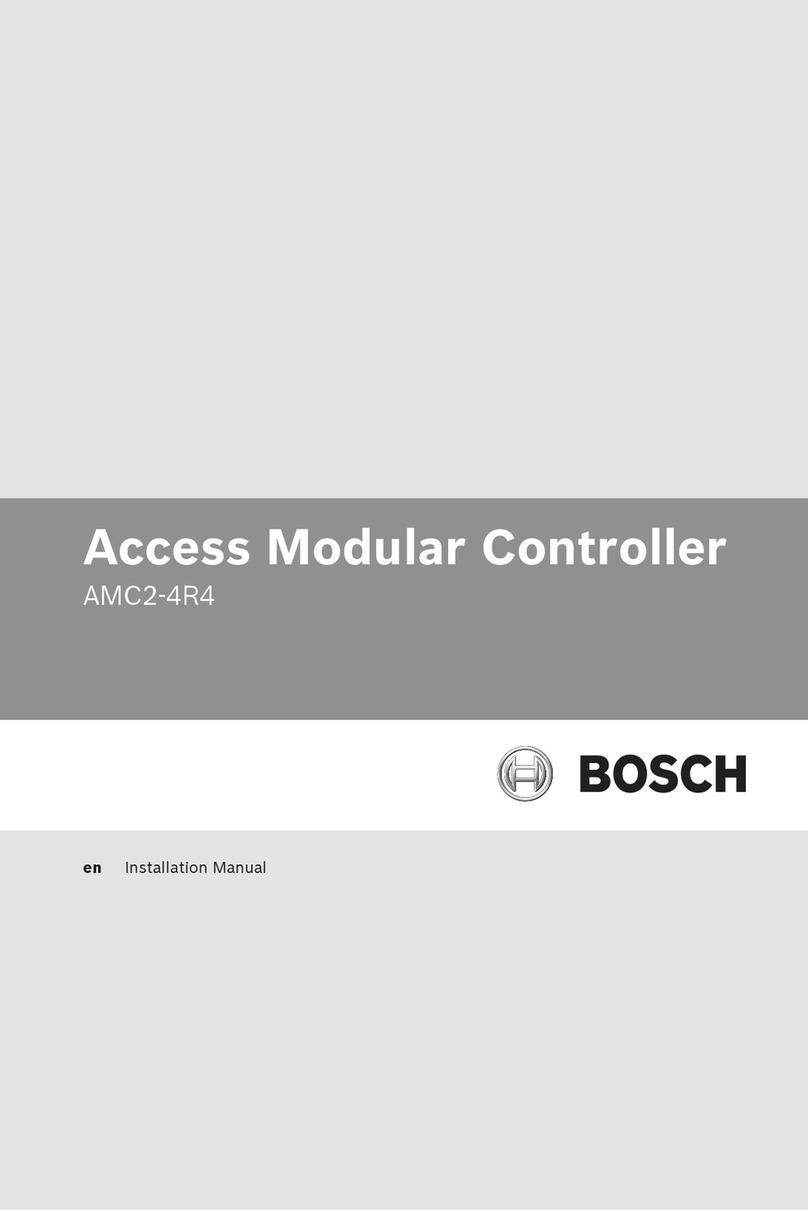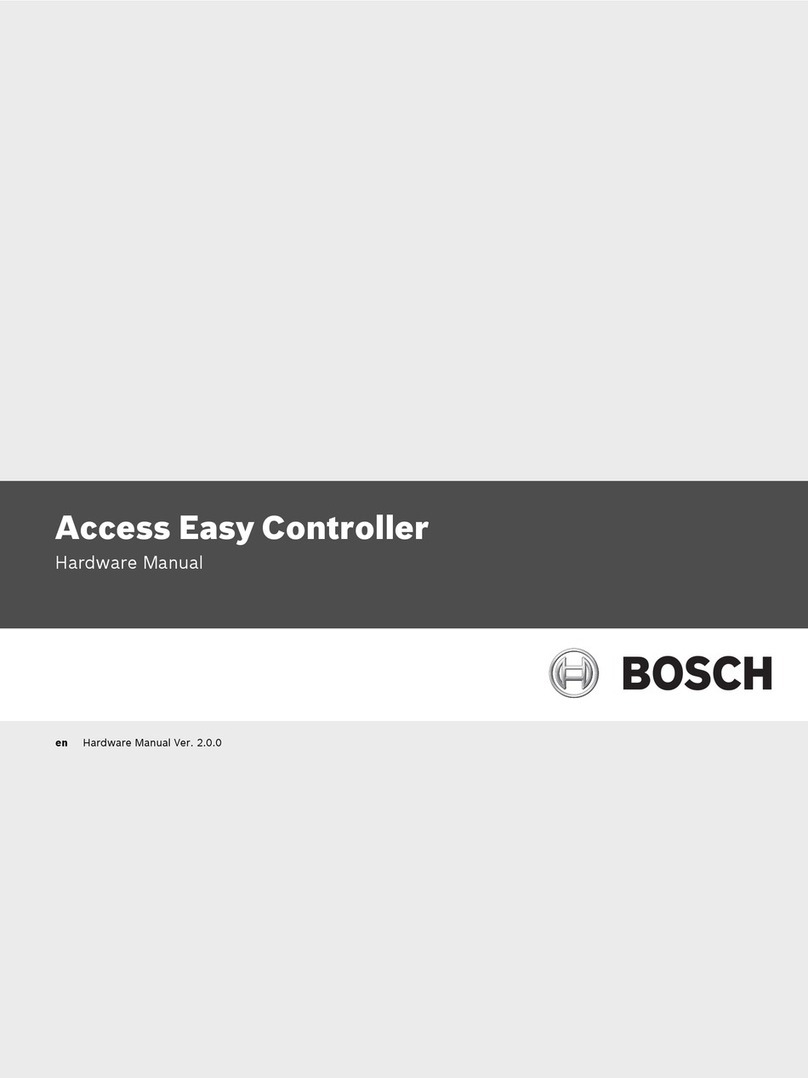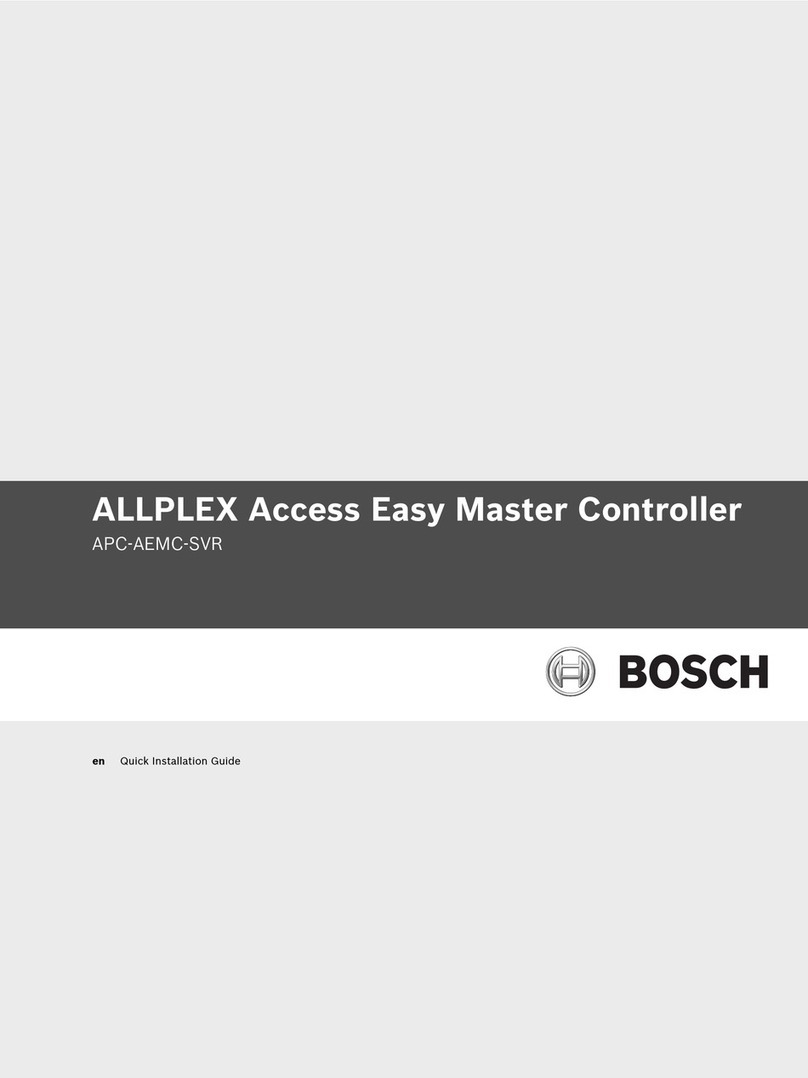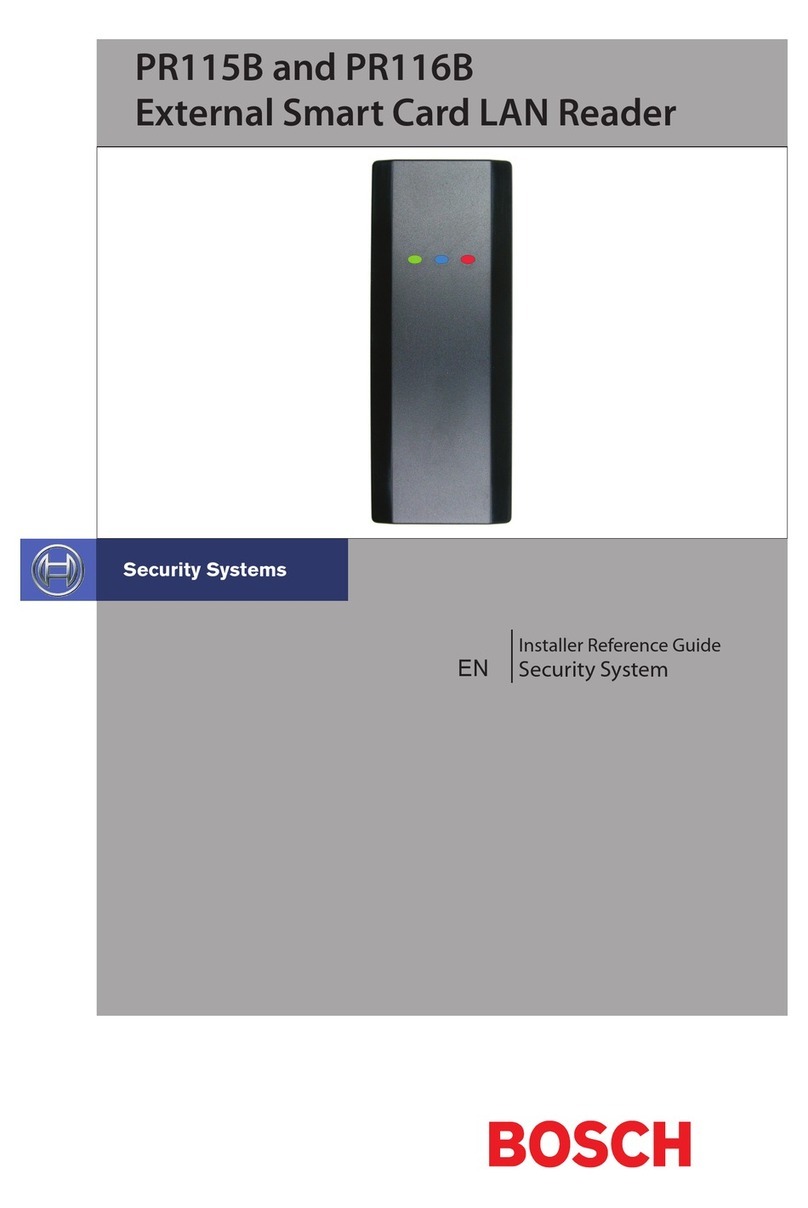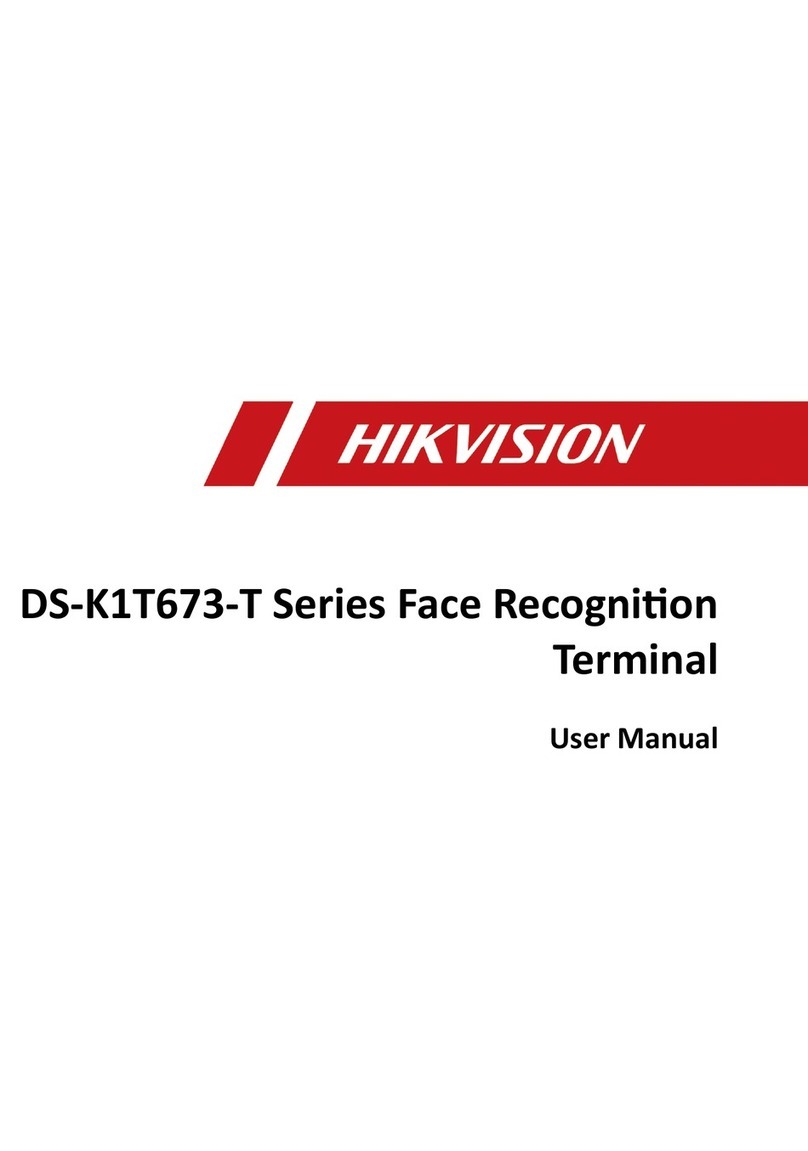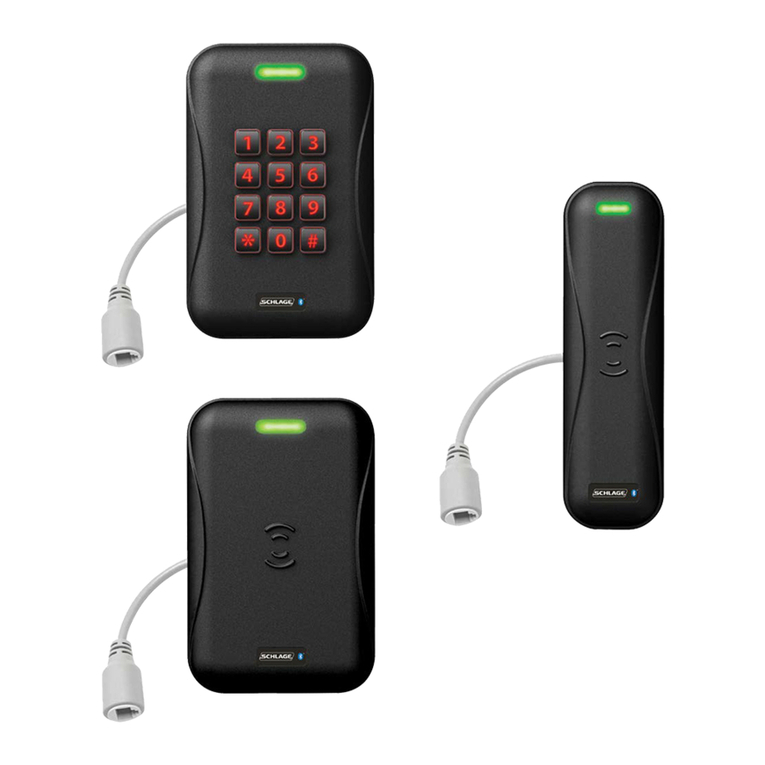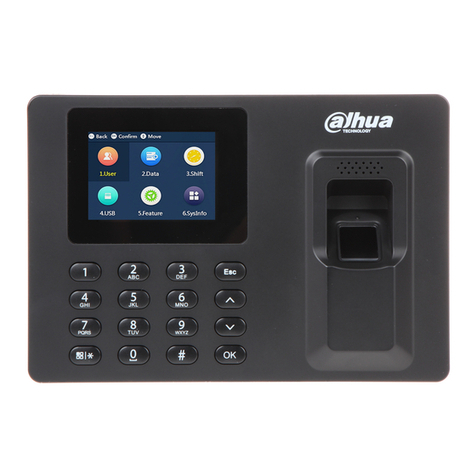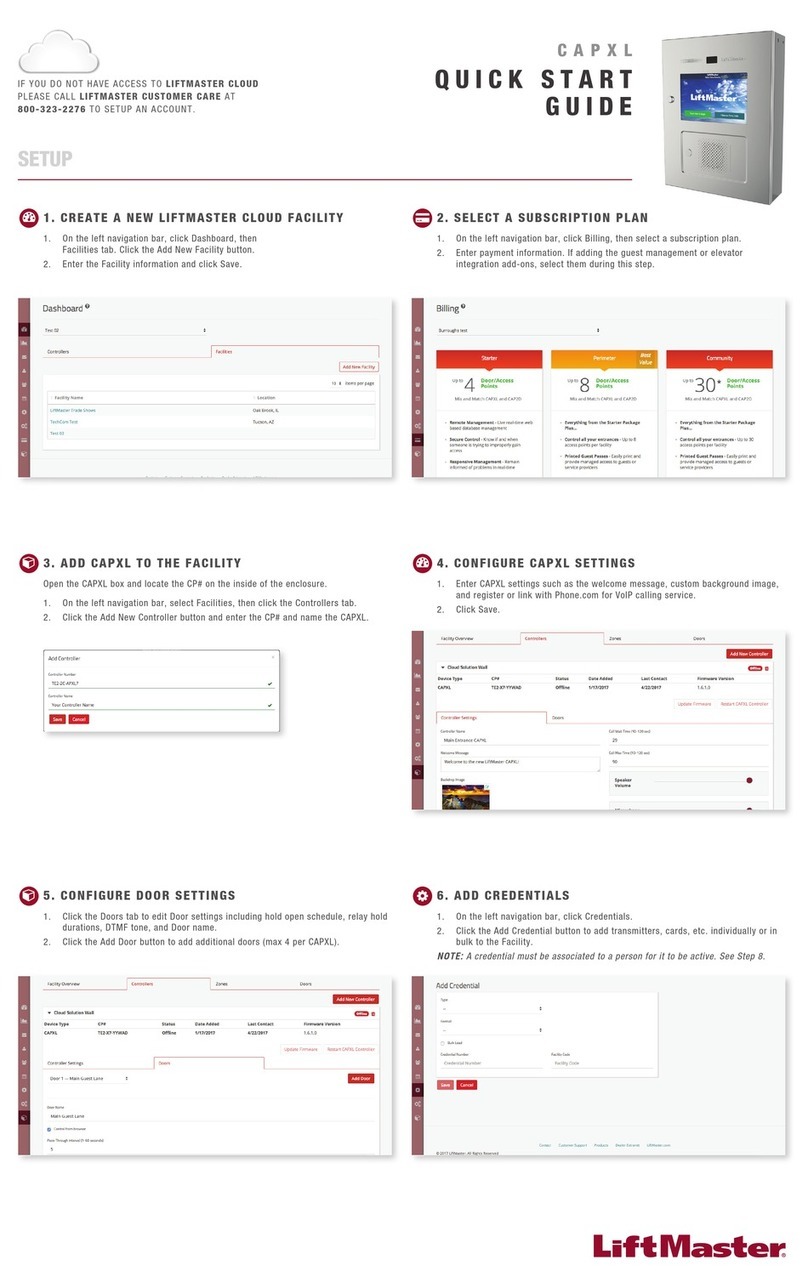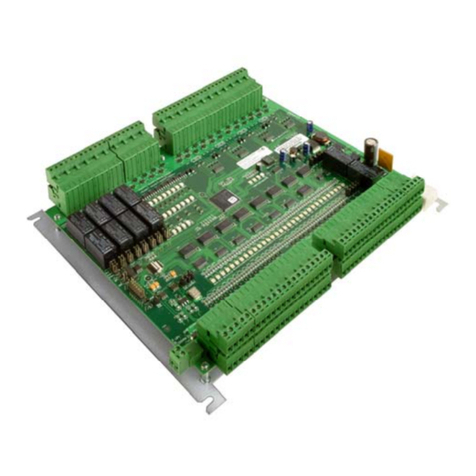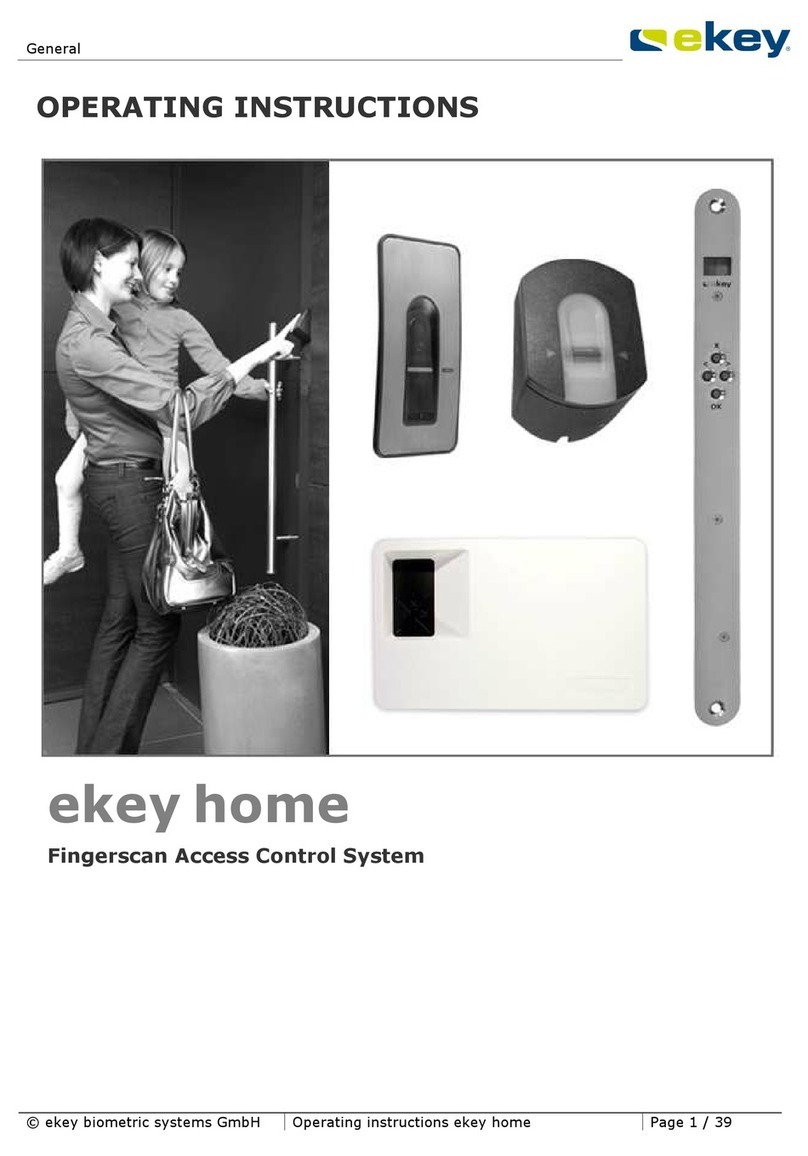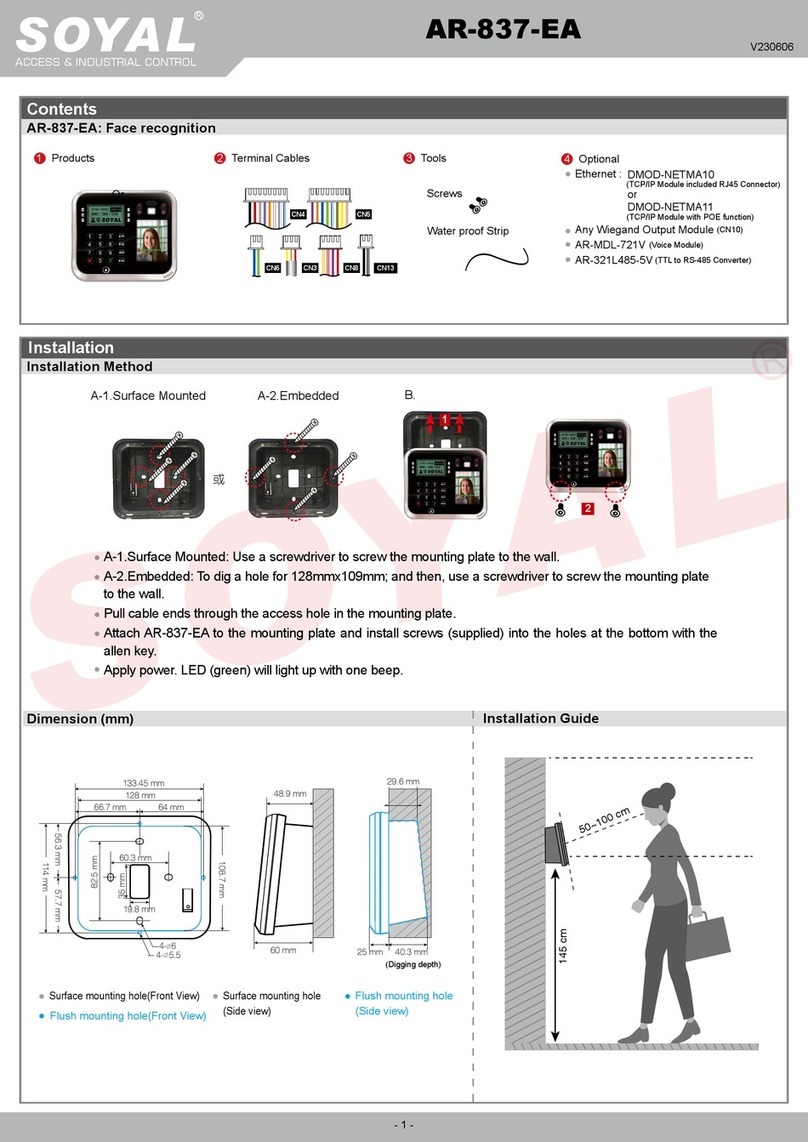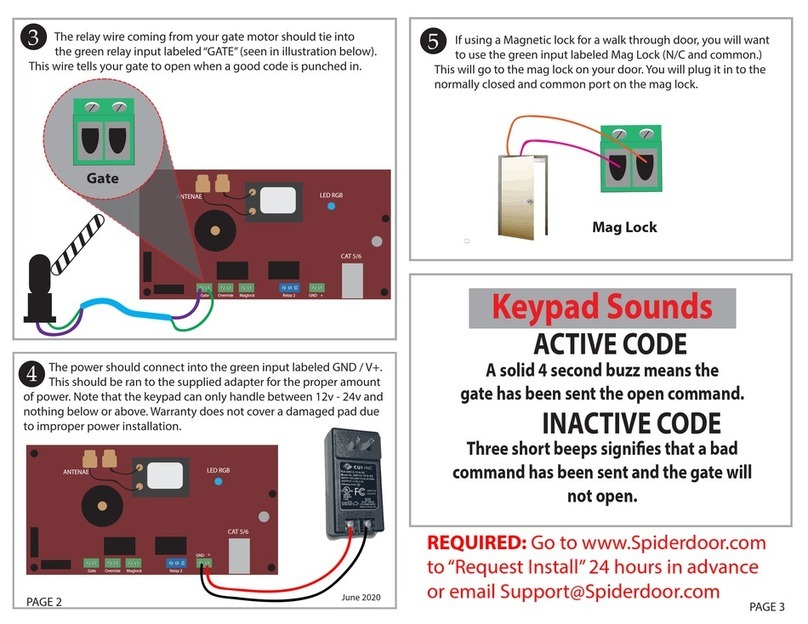Bosch 2 User manual

Access Modular Controller 2
ADS‑AMC2‑4R4CF | APC‑AMC2‑4R4CF
en Guide d'installation


Access Modular Controller 2 Table of contents | en 3
Bosch Security Systems B.V. Guide d'installation 2022-11 | V04 |
Table of contents
1Safety 5
2Short information 7
3Introduction 8
3.1 Description 8
3.2 Product overview 10
3.2.1 Mainboard 10
3.2.2 Status display 12
3.3 System overview 13
4Installing 14
4.1 Mounting the device on a mounting rail 14
4.2 Unmounting the device from a mounting rail 14
4.3 Opening the case 15
4.4 Closing the case 16
4.5 Cabling 17
4.5.1 Conductor data for powering the controller 17
4.6 Grounding and shielding 18
4.6.1 Grounding for host interface 18
4.6.2 Grounding for extension interface 19
4.6.3 Grounding for bus interfaces 19
4.7 Connecting the power supply to the controller 20
4.8 Ethernet host interface 21
4.9 RS-485 host interface 22
4.9.1 RS-485 Two Wire Connection 23
4.9.2 RS-485 Four Wire Connection 23
4.9.3 DIP switch selector 23
4.10 RS-485 for extension modules 26
4.11 RS-485 interface for card readers 27
4.11.1 RS-485 data bus system conditions 27
4.11.2 Power reader 28
4.12 Connecting relay outputs 29
4.13 Connecting analog input devices 31
4.14 Tamper protection 33
5Operating 34
5.1 Configuring Ethernet interface 34
6UL requirements 35
6.1 System requirements 35
6.1.1 Computer 35
6.2 UL 294 level descriptions 35
6.3 Installation instructions 36
6.4 Extended technical specification 38
6.4.1 RS-485 extension 38
6.4.2 Power consumption 38
7Troubleshooting 39
7.1 Resetting the software 40
7.2 Resetting the device to factory default 41
8Service and repair 42
9Disposal 43
10 Technical specifications 44

4en | Table of contents Access Modular Controller 2
2022-11 | V04 | Guide d'installation Bosch Security Systems B.V.
11 Appendices 45
11.1 Connecting diagrams 45
11.2 Status display 48
11.2.1 Bootloader V00.49 48
11.2.2 Firmware until 6x.45, 37.60 49
11.2.3 Firrmware xx.61, 37.71 50
11.2.4 Firmware xx.62, 37.72 51

Access Modular Controller 2 Safety | en 5
Bosch Security Systems B.V. Guide d'installation 2022-11 | V04 |
1 Safety
!
Warning!
Read instructions
Before working with the device, read these instructions carefully. Make sure you have
understood all information described in this document.
!
Caution!
Fire hazard and risk of electric shock due to unauthorized spare parts and accessories
Unauthorized spare parts and accessories might lack grounding wires or other safety
elements. External power supplies must be installed by qualified personnel. The service
technician must use replacement parts or accessories that are specified by the manufacturer.
!
Warning!
Risk of explosion of lithium battery
The battery can explode if it is replaced incorrectly. Pay attention to the correct polarity when
inserting.
Replace only with the same battery type, as recommended by the manufacturer.
Do not overheat or expose to fire, mechanical force, or unusual high/low air pressure
conditions.
!
Warning!
Risk of physical injury due to blocked escape routes
This product may block escape routes if not installed correctly. To keep escape routes free:
- Use locks in fail-safe mode, so that doors can be released if power fails.
- Install manual override switches, such as break-glass or lever stations, to unlock doors in an
emergency.
i
Notice!
Dispose used batteries according to the battery manufacturer’s instructions, local laws and
regulations. Batteries must be disposed of separately from household waste.
i
Notice!
Device damage due to incorrect mounting
Mount this product on the matching mounting rails.
If the device falls or is damaged, check it before the installation.
i
Notice!
Considerations on local regulations
When you install the device, consider any local fire, health and safety regulations.
i
Notice!
Device damage due to electrostatic discharge
Protect the hardware from electrostatic discharge, especially when the device is open and
exposed. Always disconnect the controller from the power source before modifying the
installation. This product does not support hot plugging.

6en | Safety Access Modular Controller 2
2022-11 | V04 | Guide d'installation Bosch Security Systems B.V.
i
Notice!
Unauthorized access
If this product is installed in an unprotected environment, unauthorized people may be able
to enter.
Install the product in a location with restricted access.
This device is not suitable for use in locations where children may be present.
i
Notice!
Some features and functions described in this document depend on the firmware loaded into
the device and host software. Make sure that the controller is updated to the firmware
version provided with the host system.
This product is RoHS compliant. See Technical data for the full table of hazardous
components.

Access Modular Controller 2 Short information | en 7
Bosch Security Systems B.V. Guide d'installation 2022-11 | V04 |
2 Short information
The AMC2 can control a maximum of eight ID readers (depending on the reader type) and fully
processes the access logic at the assigned entrances.
The device controls a group of one to eight access points. These access points, also known as
entrances, can be:
– doors
– gates
– barriers
– turn stiles
– revolving doors
– mantraps
– ID card, PIN and biometric readers
– door opening elements
– sensors.
All the product versions use encrypted connections between the access modular controller
and the host system.
The controller stores all necessary information in a battery-buffered memory and in a compact
flash storage element. Even when the unit is offline, it is able to perform:
– Independent status and authorization checks on access points
– Take access decisions
– Activate and deactivate connected peripheral elements
– Detect and register all relevant events
The Access Modular Controller (AMC) is supported by the Access Professional Edition (APE),
BIS Access Engine (ACE) and the Access Management System (AMS).
For the latest information about our products, visit our online product catalog:
www.boschsecurity.com/xc/en/product-catalog/
Manufacturing dates
For product manufacturing dates, go to www.boschsecurity.com/datecodes/ and refer to the
serial number on the product label.
Remarks
This hardware is part of a security system.
Access should be granted to authorized people only.
Some states do not allow the exclusion or limitation of implied warranties, or limitation of
liability for incidental or consequential damages, hence the above limitation or exclusion might
not apply to you.
If you need further assistance or have any questions, contact:
Bosch Security Systems B.V.
Torenallee 49
5617 BA Eindhoven
Netherlands
www.boschsecurity.com
© Bosch Security Systems B.V., 2022

8en | Introduction Access Modular Controller 2
2022-11 | V04 | Guide d'installation Bosch Security Systems B.V.
3 Introduction
3.1 Description
Figure3.1: Access Modular Controller
Unsecured Area
Secured Area
Figure3.2: Example
The controller has four independent interfaces for RS-485 type readers. It can control a
maximum of four doors with a reader in each direction and a maximum of eight doors with a
reader in one direction only.
The electronics of the controller are completely covered by a plastic housing. The LCD (liquid
crystal display) provides all important status information.
All necessary information for access verification is stored in a battery buffered on-board
memory and a Compact Flash (CF) memory card. This guarantees autonomous access
decisions and complete access registrations even if the management host system is offline.
The built in compact flash adapter provides adequate storage capability for cardholders and
events.
The controller can communicate upstream to the host computer using one of the following
interfaces:
– Ethernet
– RS-485 multi-dropped, not supported by:

Access Modular Controller 2 Introduction | en 9
Bosch Security Systems B.V. Guide d'installation 2022-11 | V04 |
– BIS 4.9.1 and later
– AMS 4.0 and later.
The controller has eight analog input devices and eight relay outputs. With its analog input
devices, the controller verifies, for example, if a lock is closed or open. The relay outputs can
be used, for example, to activate lock mechanisms if access is granted, or activate the burglar
alarm system if an intrusion or system alert is detected. If the eight inputs and eight outputs
on the board are not enough to configure the system, up to three additional extension boards
can be connected. The extensions offer 8 or 16 additional inputs and outputs.
In the Bosch Access Host Systems, the setup procedure for a controller is made very simple
and fast by the use of door templates. Once selected, all the inputs and outputs are
predefined. These settings can be changed to choose every free contact of the controller or a
connected extension.
The product name and marking can be found on the backside of the product housing.

10 en | Introduction Access Modular Controller 2
2022-11 | V04 | Guide d'installation Bosch Security Systems B.V.
3.2 Product overview
3.2.1 Mainboard
1
7
3 4 52
10 11
89
6
Figure3.3: Upper circuit board with display (front)
1 DIP switch for RS-485 address and protocol selection.
2 Lithium battery for buffering of static RAM and real time clock (RTC). The battery life
is estimated at 10 years, nevertheless an error message is generated if the voltage
sinks below a preset minimum level.
NOTICE: In order to avoid an error message caused by an earlier voltage drop we
suggest to replace the battery every 8 years. Spare part: VARTA CR 2032 PCB.
3 Reset push button - reachable through the casing using a screwdriver
4 Liquid Crystal Display
5 Push button, available on top of the housing, to select different display modes
6 Jumper: Equalization of potential between different systems and earth ground
(shield)
7 Jumper: Interface selector RS-485 host connection, RS-485 two wire or RS-485 four
wire (depends on external wiring)
8 Configurable RS-485 host interface
9 Compact flash memory
10 Project-specific interface
11 Configurable 10/100 Mbit/s Ethernet host interface

Access Modular Controller 2 Introduction | en 11
Bosch Security Systems B.V. Guide d'installation 2022-11 | V04 |
12 13
14 15 1516 17 16 17
15 16 17 15 16 17
Figure3.4: Interfaces - overview
12 RS-485 extension module bus
13 External tamper contact
14 Connector for power supply
15 RS-485 interfaces for card readers
16 Connectors for analog inputs
17 Connectors for relay outputs
20
18 19
19
Figure3.5: Jumper at the bottom side
18 Jumper for setting either voltage free relay output (“dry” mode) or looped-in voltage
from the AMC2 internal power supply (“wet” mode).
19 Jumper: Potential equalization between different systems and earth ground (shield)
for the bus systems.
20 Jumper: Equalization of potential between different systems and earth ground
(shield) for the extension interface.

12 en | Introduction Access Modular Controller 2
2022-11 | V04 | Guide d'installation Bosch Security Systems B.V.
3.2.2 Status display
Figure3.6: Dialog button of the controller
The liquid crystal display delivers status information about the controller. Push the dialog
button to switch between different modes.
The selected display mode remains set until the next time the button is pressed.
The display pages depend on the firmware loaded into the controller. The order of the display
pages available on delivery (Bootloader V00.49) is shown in the following table.
For information on display pages available for the different firmware (FW) variants, refer to
Status display, page 48
.
Push Display (Example) Description
0 V00.49 dd.mm.yy Bootloader version by factory
dd.mm.yy release date of the firmware
1 S/N1: 0910024419 Serial number 18 digits - Part1 10 digits
2 S/N2: 22850034 Part 2 - 8 digits
3 11.18 12:24:18 S Current date and time (MM.DD hh:mm:ss)
(S) = daylight saving
4 MAC 001B860012AB Network device address (MAC)
5 N AMC-1234-5678 Network name of the controller (max. 14 char.)
See
Configuring Ethernet interface, page 34
.
6 I 192.168.10.18 IP-address of the controller
7 G 192.168.10.255 IP-address of the gateway
8 M 255.255.255.0 Subnetmask
9 H 192.168.10.10 IP-address of the host computer
10 DHCP 1 DHCP-status: 1 = on; 0 = off
11 D 192.168.10.1 IP-address of the DNS server
12 Host: + "C" Host activity:
+ = online
- = offline
"C" = Counter (0 to 9) of the received data
packages from the host interface.
RS 485 Bus connection:
A = Address 1 … H = Address 8

Access Modular Controller 2 Introduction | en 13
Bosch Security Systems B.V. Guide d'installation 2022-11 | V04 |
3.3 System overview
The controller can be connected to the host system through one of the following interfaces,
depending on the type of installation:
– Ethernet
– RS-485 multi-dropped, not supported by:
– BIS 4.9.1 and later
– AMS 4.0 and later.
The host interface is selected during installation.
The four reader interfaces are available on the device.
With RS485 operation, a maximum of eight access controllers can be connected to one party
line.
2
3
3
2
1
2 2
3
3
4 4
1 Host computer
2 Access Modular Controller
3 Card reader
4 Communication and power supply
In the communication chain of a system, the access controller is integrated between the host
system and the peripheral devices.
It is possible to connect a maximum of eight readers to the access modular controller.
The four reader interfaces are divided into two physical buses. Interface 1 and 2 are on one
bus, and interfaces 3 and 4 are on the other bus. This gives the advantage in cabling: longer
cable lengths can be used (1200m maximum per bus). Internally the buses are processed as
one interface. With this arrangement, you can connect all readers to one interface.

14 en | Installing Access Modular Controller 2
2022-11 | V04 | Guide d'installation Bosch Security Systems B.V.
4 Installing
4.1 Mounting the device on a mounting rail
The controller can be attached on a standard 35mm (1.377in.) mounting rail using a snap-in
mechanism. Attach the controller into the upper edge of the mounting rail [1], then push
down the device and snap it onto the rail by pushing it towards the back [2].
1 2
Figure4.1: Mounting the controller on a mounting rail
For information on how to install the device in an enclosure, refer to the separate instruction
manual of the enclosure AEC-AMC2-UL01 or AEC-AMC2-UL02. After installing the device, keep
the door of the enclosure closed.
4.2 Unmounting the device from a mounting rail
i
Notice!
To remove the controller from a mounting rail, first remove all pluggable connectors.
Push down the controller until the lower edge snaps out of the mounting rail [1]. Pull the
lower end of the controller from the mounting rail [2].
1 2
Figure4.2: Unmounting the controller from a mounting rail

Access Modular Controller 2 Installing | en 15
Bosch Security Systems B.V. Guide d'installation 2022-11 | V04 |
4.3 Opening the case
i
Notice!
To open the controller, first remove all pluggable connectors.
The controller’s case consists of a top cover mounted with a two-point snap-in closure on a
chassis. To open the case, push down the two snap-ins with a screwdriver, then swing the
cover down.
Figure4.3: Opening the controller´s case

16 en | Installing Access Modular Controller 2
2022-11 | V04 | Guide d'installation Bosch Security Systems B.V.
4.4 Closing the case
Before aligning the covers, unplug any pluggable screw connectors. Insert the hooks on the
lower edge of the front cover into the lugs on lower edge of the plastic back cover [1]. Please
ensure that the BOSCH logo is not upside-down. The upper edge of the front cover now aligns
with the two-point snap-in closures on the upper edge of the back cover [2], and may thus be
clicked gently into place.
Hence the closing process is the reverse of the opening process.
1
2
Figure4.4: Closing the case
i
Notice!
Risk of damage to equipment
If excessive force is required to close the front cover then it is probably incorrectly hooked
into the back cover. In such cases the display dialog button in the front cover will be
misaligned and will not function correctly.

Access Modular Controller 2 Installing | en 17
Bosch Security Systems B.V. Guide d'installation 2022-11 | V04 |
4.5 Cabling
i
Notice!
Risk of malfunction
The cables used in the controller are not prone to electrical interference. However, you
should avoid routing cables close to heavy load switching cables and equipment. If this is
unavoidable, cross the cable at right angles every 1 to 2 m (3 to 6 ft) to reduce interference.
4.5.1 Conductor data for powering the controller
With the calculation below you can find out which cable type must be used. If you connect the
power supply and the controller with the delivered cable set from the enclosure the
calculation is not necessary.
For distances below 25m (75ft) use AWG18 conductors (1mm²). For longer distances, install
an additional power supply close to the controller.
Please, calculate the voltage drop by checking the conductor specifications for characteristic
resistance values. The voltage drop shall not exceed 2V.
Example:
Length = 100 m/328 ft
Critical condition! Install the power supply closer to the controller.
i
Notice!
These specifications apply to power supply, readers, relay outputs, and extension interface.
Regarding inputs, specific voltage-drop values need to be taken into account. Refer to
Connecting Analog Input Devices.

18 en | Installing Access Modular Controller 2
2022-11 | V04 | Guide d'installation Bosch Security Systems B.V.
4.6 Grounding and shielding
The main grounding point at the controller is connected to pin 2 of the power supply
connector.
For more information on these connections, refer to
Connecting diagrams, page 45
.
It is good practice to shield all wires carrying low level signals.
The controller allows you to create a central ground or shielding point, simply by setting
certain jumpers. Set these jumpers only if grounding or shielding is not achieved by other
means.
i
Notice!
The functional earth ground symbol identifies a functional part that allows installing an
electrical system in an electromagnetically compatible manner.
i
Notice!
Risk of malfunction
Ensure that no ground loops are formed.
i
Notice!
In general the following apply:
If the devices have their own power supplies, the shielding is applied to one side only. The
free end should be insulated to avoid inadvertent connections.
If one device is fed power by another, the cable shielding should be applied to both sides.
4.6.1 Grounding for host interface
A 1:
A 2:
A 3:
JP1
JP2
JP1
JP2
A
Figure4.5: Location of ground jumper RS-485 host interface
A1 Delivery status
The internal ground of the controller is always connected with the ground of the RS485 host.
The jumper setting A1 shows the factory settings.
Jumper JP1 connects the internal ground of the controller to the ground of the RS-485 host
interface.
Jumper JP2 manages the signal ground.
Settings for jumper JP1:
If the ground conductor and the shield on the host are not connected and:
– no party line exists, the jumper JP1 is set (=A2)
– a party line exists, the jumper JP1 is set at the first device only (=A2)

Access Modular Controller 2 Installing | en 19
Bosch Security Systems B.V. Guide d'installation 2022-11 | V04 |
Settings for jumper JP2:
If the ground conductor and the shield on the host are not connected and:
– no party line exists, the jumper JP2 is set (=A3)
– a party line exists and signal ground is connected, the jumper JP2 is set at the first device
only (=A3)
– a party line exists and signal ground is not connected, the jumper JP2 is set at all devices
(=A3)
4.6.2 Grounding for extension interface
B 1:
B 2:
B
Figure4.6: Location of ground jumper bottom side
B1 Delivery status
Jumper B connects the internal ground of the controller to the RS-485 ground of the slave
interface. Only set jumper B (B2) if the controller powers all other peripheral devices directly
connected to it.
4.6.3 Grounding for bus interfaces
C 1:
C 2:
D 1:
D 2:
C
D
Figure4.7: Location of ground jumper bus interfaces
C1, D1 Delivery status
Jumper C (for the second bus) and jumper D (for the first bus) connect the internal ground of
the controller to the RS-485 ground of the bus.
Only set jumper C and D (C2 or D2) if the controller powers all other peripheral devices which
are directly connected.

20 en | Installing Access Modular Controller 2
2022-11 | V04 | Guide d'installation Bosch Security Systems B.V.
4.7 Connecting the power supply to the controller
Connect the power supply to the POWER 7-pin pluggable screw connector.
Figure4.8: Location of the power supply connector
Connect an external power supply (10 VDC - 30 VDC) to the controller at pin 1 (positive) and
pin 3 (0V) of the pluggable screw connector.
Bosch recommends using the Bosch APS-PSU-60 power supply unit.
This power supply can also be used as an uninterpretable power supply (UPS) when using the
appropriate batteries. It also has relay outputs for monitoring the power good signals. These
can be connect to
– pin 4 and 7 for power good AC
– pin 5 and 7 for power good Battery
– pin 6 and 7 for power good DC
If the recommended power supply is not in use, it is useful to have these pins short-circuit.
i
Notice!
If a battery is used, the power supply unit (PSU) checks the battery status every 5 minutes.
During the self-test, the PSU switches its output from AC regulated power to battery
regulated power. This causes the AMC to be supplied by the battery only.
Make sure that the battery is maintained according to the advice of the manufacturer, in order
to reduce the risk of losing the power on the AMC controller during self-test.
The duration of this self-test is of approximately 1 second.
The Power Good AC signal is switched off during the self-test.
If no battery is connected, the PSU does not perform any self-test.
Depending on the security level of your building, it is recommended to replace the battery
more frequently (e.g. every 3 years, in order to keep the system running properly).
i
Notice!
Unstable AC networks can result in various error messages on the host system. If this
happens, the AMC only reports AC power losses of more than 10 minutes of duration. This
time cannot be set.
Other manuals for 2
11
This manual suits for next models
2
Table of contents
Other Bosch IP Access Controllers manuals
Popular IP Access Controllers manuals by other brands

AWID
AWID SENTINEL-PROX MR-1824 Installation & operation manual

Sanela
Sanela SLZA 40GV Mounting instructions
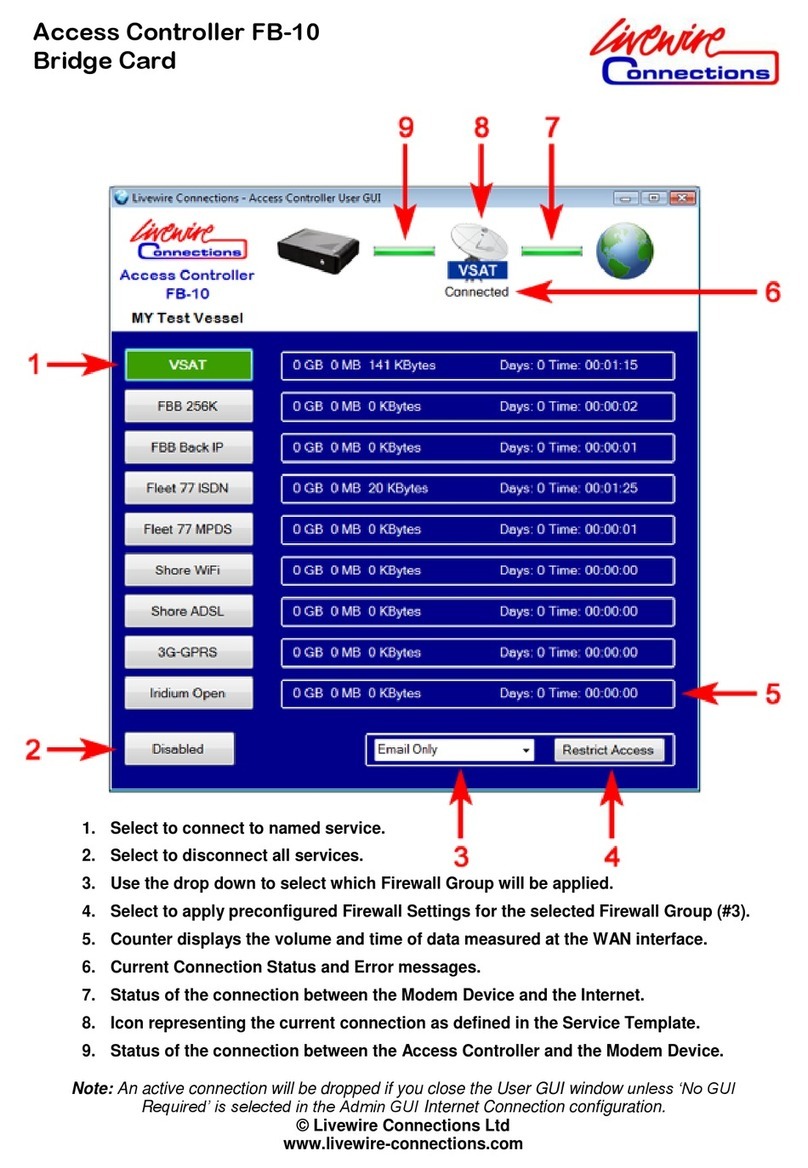
Livewire Connections
Livewire Connections FB-10 quick start guide
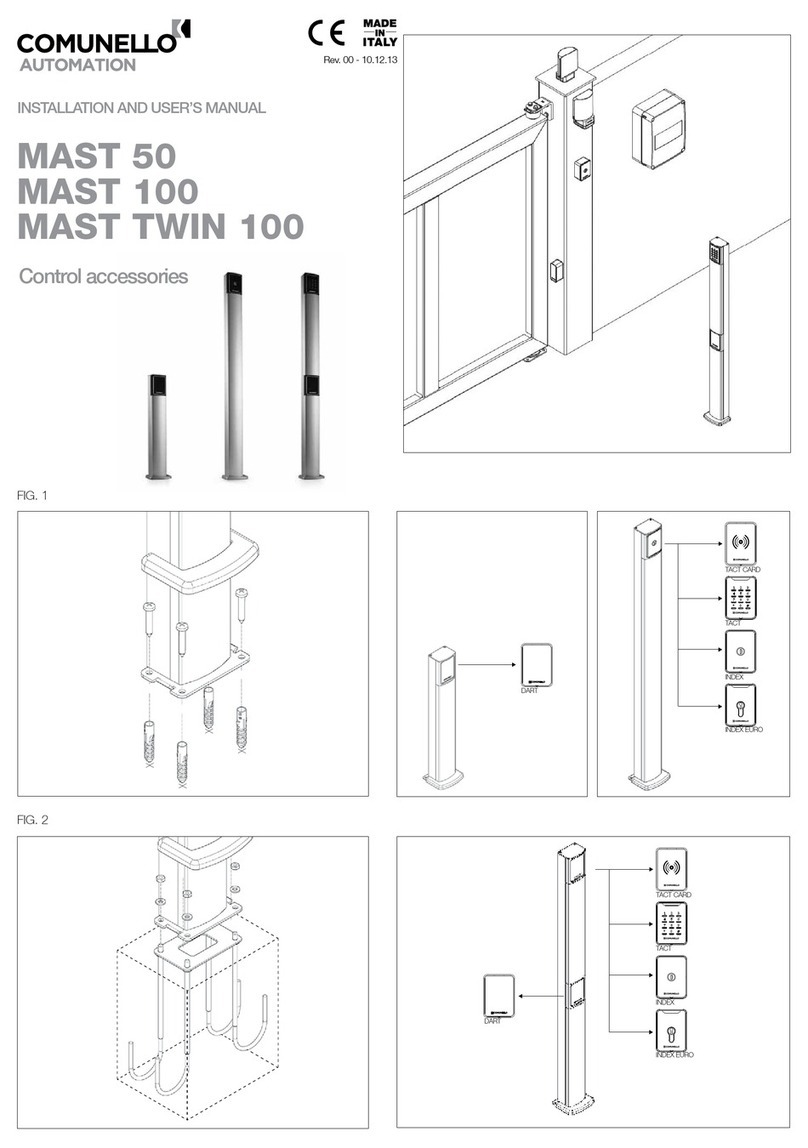
Comunello Automation
Comunello Automation MAST 50 Installation and user manual
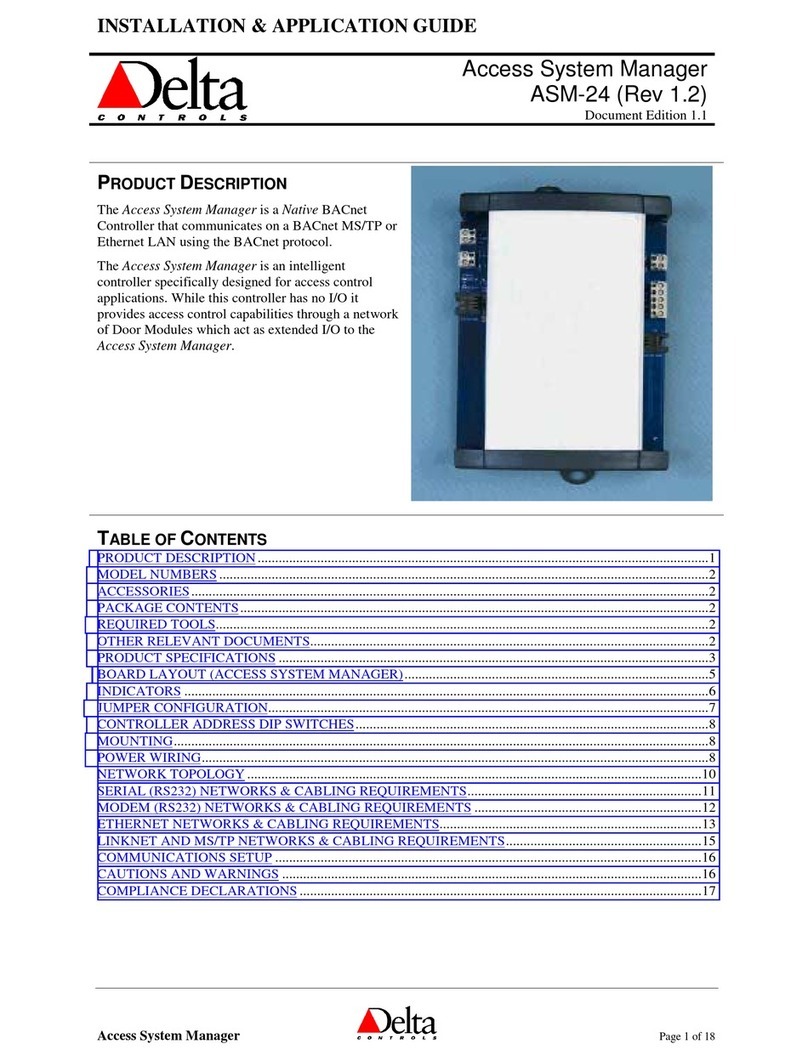
Delta Controls
Delta Controls ASM-24 Installation & Application Guide
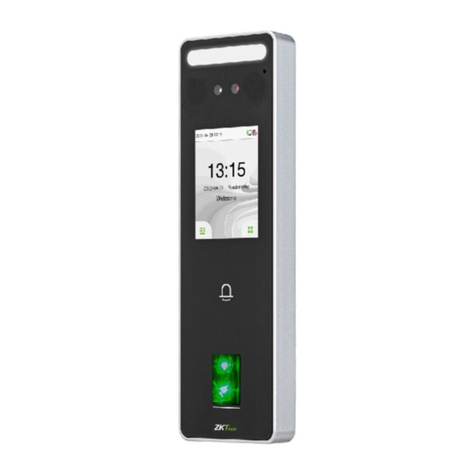
ZKTeco
ZKTeco SpeedFace-V3L user manual
